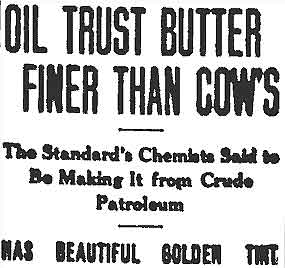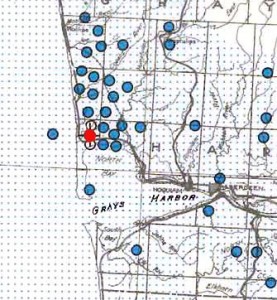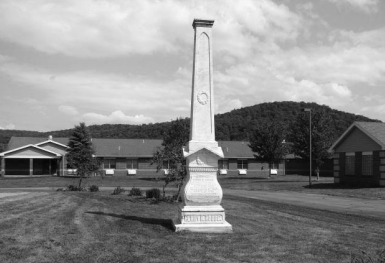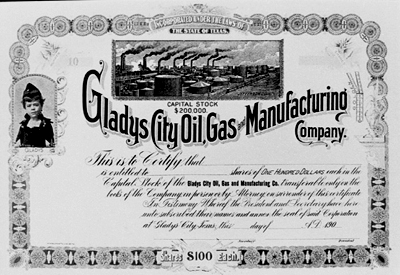This Week in Petroleum History: August 19 – 25
August 19, 1909 – Canadian Journal lampoons Standard Oil –
“The Standard Oil Company has decided to drive the cow and the dairyman out of business,” declared the Stanstead Journal of Quebec, reporting from Jersey City, New Jersey. “Its skilled chemists have discovered a process whereby they can make gilt-edge butter as a byproduct of crude petroleum.”

Journalists found humor in the approaching breakup of the Standard Oil Trust.
The journal fancifully proclaimed, “The chemists, in the steps leading up to the petroleum butter discovery, also have perfected a cheap process by which they can convert the kerosene into sweet milk.”
August 19, 1957 – First Commercial Oil Well in Washington
The first and only commercial oil well in the state of Washington was drilled by the Sunshine Mining Company. The Medina No. 1 well flowed 223 barrels a day from a depth of 4,135 feet near Ocean City in Grays Harbor County. The well produced 12,500 barrels before being capped in 1961.

Surrounded by unsuccessful attempts, Washington’s only commercial oil well (red) was capped in 1961.
By 2010, about 600 oil and natural gas wells had been drilled in Washington, but large-scale commercial production never occurred. The state’s most recent production — from the Ocean City field — ceased in 1962, according to the Washington Commissioner of Public Lands. No oil or gas has been produced since.
August 20, 1971 – Penn-Brad Oil Museum opens in Pennsylvania
Preserving the 1880s history of the world’s first billion dollar oilfield, the Bradford, Pennsylvania, Penn-Brad Oil Museum opened in nearby Custer City. At the end of the 19th century, the region produced high-quality oil from the upper Devonian Bradford Sands — accounting for more than 80 percent of U.S. production.
“A light golden amber to a deep moss-green in color, the ‘miracle molecule ‘ from the Bradford field is high in paraffin and considered one of the highest grade natural lubricant crude oils in the world,” explains the museum.

The Penn-Brad Museum and Historical Oil Well Park of Bradford, Pennsylvania, celebrates its 53rd birthday on August 20. Photo by Bruce Wells.
Outdoor exhibits include a replica 72-foot standard cable-tool derrick and engine house, and guided tours by oil country veterans educate visitors about “yellow dogs and barkers, headache posts, hurry-up sticks and sucker rods.”
Learn more Bradford oilfield history in Mrs. Alford’s Nitro Factory.
August 21, 1897 – Olds Motor Vehicle Company founded
American automotive pioneer Ransom Eli Olds (1864–1950) founded the Olds Motor Vehicle Company in Lansing, Michigan. Renamed Olds Motor Works in 1899, the company became the first auto manufacturer established in Detroit.
By 1901 Olds had built 11 prototype vehicles, including at least one powered by steam, electricity, and gasoline, according to historian George May. “He was the only American automotive pioneer to produce and sell at least one of each mode of automobile.”

Powered by a single-cylinder, five-horsepower gasoline engine, the 1901 Oldsmobile Curved Dash was the first mass-produced U.S. automobile.
The modern assembly line concept also began with Olds, who used a stationary assembly line (Henry Ford would be the first to use a moving assembly line). Olds Motor Works sold the first mass-produced automobile in 1901, one year after the first U.S. Auto Show.
When the last Oldsmobile rolled off an assembly line in Lansing in 2004, it was the end of America’s oldest automotive brand.
August 21, 1993 – Henry Rouse Monument rededicated
Family members rededicated the original 1865 monument to Henry R. Rouse at his estate near Youngsville, Pennsylvania. Rouse — a respected leader of the early oil industry — died on April 17, 1861, when his highly pressurized well exploded in flames at Rouseville (see Rouseville 1861 Oil Well Fire).

The 1865 monument to Henry Rouse was rededicated in 1993 during the annual family Picnic in Warren County, Pennsylvania. Photo courtesy the Rouse Estate.
The marble monument stands at the entrance to the Rouse Home, which has served the poor of the county as Mr. Rouse intended, according to the Rouse Estate, “a testimony to his philanthropy, and a reminder of the important role played by Rouse in serving the needs of the Warren County community.”
August 24, 1892 – Oil Company founded by “Prophet of Spindletop”
Patillo Higgins, who would become known as the “Prophet of Spindletop,” founded the Gladys City Oil, Gas & Manufacturing Company and leased 2,700 acres near Beaumont, Texas. Higgins believed oil-bearing sands could be found four miles south of town. Most earth science experts said he was wrong.
A self-taught geologist, Higgins had noticed oil and natural gas seeps at Spindletop Hill while taking his Sunday school class on picnics. He later supervised the planning of Gladys City, which he named for his favorite student.

Patillo Higgins was no longer with the company he had founded when it discovered oil at Spindletop Hill in January 1901.
Although Higgins left the Gladys City venture in 1895, Capt. Anthony Lucas drilled the “Lucas Gusher” for the company in January 1901 and forever changed the petroleum industry (the oilfield produced more oil in one day than the rest of the world’s fields combined). Gulf Oil, Texaco, Mobile, and Sun Oil companies got their start thanks to Patillo Higgins’ confidence in the “Big Hill.”
Learn more in Prophet of Spindletop.
August 24, 1923 – University of Texas receives Royalty Check
The University of Texas received the first oil royalty payment ($516.53) three months after the Santa Rita No. 1 well discovered an oilfield on university-owned land in the Permian Basin. After 21 months of difficult drilling, the Texon Oil and Land Company’s well had revealed the 4.5-square-mile Big Lake field.

Drilling and production equipment from the Santa Rita No. 1 well is preserved at the University of Texas. Photo by Bruce Wells.
Within three years of the Big Lake discovery, petroleum royalties endowed the university with $4 million. In 1958, the university moved the Santa Rita well’s walking beam and other equipment to the Austin campus. A student newspaper described the historic well as “one that made the difference between pine-shack classrooms and modern buildings.”
August 24, 1937 – Music Mountain Oil Discovery
No one had expected it, not even the Niagara Oil Company that drilled it, notes the Bradford Landmark Society about a 1937 gusher near Bradford, Pennsylvania, in McKean County. For the first time since the great Bradford field discovery 70 years earlier, an exploratory well on Music Mountain revealed a new oilfield.
The producing formation was beneath the older, highly prolific Bradford sands. The region’s high-paraffin oil is still considered among the best natural lubricants in the world. A refinery (today’s American Refining Group) has been processing McKean County oil since 1881.
_______________________
Recommended Reading: R.E. Olds: Auto Industry Pioneer (1977); Spindletop: The True Story of the Oil Discovery that Changed the World (1980); Giant Under the Hill: A History of the Spindletop Oil Discovery at Beaumont, Texas, in 1901
(2008); Santa Rita: The University of Texas Oil Discovery
(1958); Images of America: Around Bradford
(1997). Your Amazon purchase benefits the American Oil & Gas Historical Society. As an Amazon Associate, AOGHS earns a commission from qualifying purchases.
_______________________
The American Oil & Gas Historical Society (AOGHS) preserves U.S. petroleum history. Please become an AOGHS annual supporter and help maintain this energy education website and expand historical research. For more information, contact bawells@aoghs.org. Copyright © 2024 Bruce A. Wells. All rights reserved.



